#7th millennium
Explore tagged Tumblr posts
Text

Millenniums of 1001 and 9999
#millennium#millenniums#2nd millennium#3rd millenniun#4th millennium#5th millennium#6th millennium#7th millennium#8th millennium#9th millennium#10th millennium#big bang#big crunch#big bang and big crunch
0 notes
Text
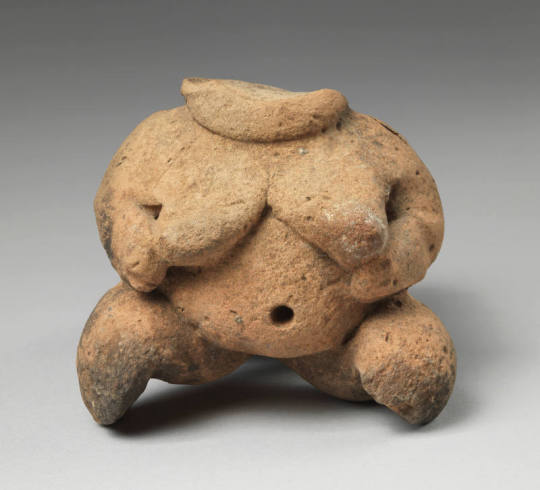
~ Female Fertility Figurine.
Place of origin: Türkiye
Period: Neolithic
Date: 7th Millennium B.C.
Medium: Ceramic
#ancient#ancient art#history#museum#archeology#ancient sculpture#ancient history#archaeology#female fertility figurine#Neolithic#türkiye#turkish#ceramic#7th millennium B.C.
2K notes
·
View notes
Text

The paddle of Duvensee is a well-preserved piece of a Mesolithic paddle found in 1926 during excavations in the Duvenseer Moor near Klinkrade in the Duchy of Lauenburg district of Schleswig-Holstein, Northern Germany. The find is the second oldest paddle in the world after the Star Carr paddle and is considered one of the earliest evidences of the use of water vehicles in the Mesolithic period. It was made of oak wood and measures 790 × 182 × 35 mm with a weight of 613 g. Dendrochronological examinations have shown that it dates from the 7th millennium BC.
348 notes
·
View notes
Text
I am NOT a 3/14 N birthday believer.
#giving the nerdy math related characters a 3/14 birthday is SO overdone. yawn#his birthday. to ME. is february 7th#eulers number reference :)#it also makes him an Aquarius sun and Pisces moon which is SO him#i also like to make his birth year 2000. the turn of the millennium. idk it's kinda fitting i think#n harmonia#2024#fae chimes
2 notes
·
View notes
Text



Triple Bakura! (Artwork from my recent Off the Cuff episodes, going thru the Millennium Enemy arc from the 6th and 7th volumes of the YGO manga)
739 notes
·
View notes
Note
Just wanted to say I’m enjoying all of the world building and snippets from AEIWAM - it’s clear how much fun you’re having and how much though you put into it. I’ve started rereading bleach because of that, though I always wind up stopping after the rescue rukia arc 😅. Maybe I’ll make it past that this time.
Eh, I gave up after My Blorbo was killed off in deeply narratively unsatisfying fashion, so you're not alone. Anyway, have some More AEIWAM Worldbulding Nonsense:
---
The Kuchiki-Yamada-11th Division Fucktangle
-
It started with Chigiri Shijima.
The first captain of the 4th Division, part of the original Dirty Dozen Yamamoto hired off of Death Row to fight the first Quincy Invasion, was an unassuming and chronically fatigued looking woman* with a profound sense of curiosity about the limits of The Flesh:

(from Kubo's sketches of the original 13) *Chigiri might be male in canon. I don't care
She became fast friends with the young Yachiru Unohana, who shared her fascination with the limits of the flesh, though from the opposite direction. Chigiri was the first person to show Unohana how to channel her Reiatsu to prefrom Kaido, and let her sit in on /Hold people's ribcages open during /do some of the surgical cuts for Chigiri's Field Surgery sessions, much to the horror of everyone else involved.
After the War, when the Captains had to shape up from a gang of mercenaries into a real governmental organization, Chigiri met and eventually married a Similarly-Sadistically-Curious young Dentist named Fumihiro Yamada. Longtime friend and frequent visitor to the hospital Unohana attended the 100-day ceremony of their first and subsequent six children, the start of a grand tradition- Unohana, under one name or another, has been present at the Okuizome of every Yamada born for the last millennium, and delivered most of them for the last 800-odd years.
The Yamadas are one of the most prolific Shinigami families, producing more Shinigami by percentage than any other clan, and have served in all divisions of the court Guard. Eighth Division Fifth Seat Suichi Yamada is the current highest ranked Yamada, but there have been four Captains Yamada. There's also a Seated Yamada in the third divison, and another in the 12th (though there's a popular rumor that 15th Seat Tosako Yamada isn't part of the 12th so much as a Spy to keep the 4th abreast of any important developments in medical science, rather than deal with Mayuri directly).
It is little wonder then that, despite the lack of noble standing, the Yamadas are one of the most highly regarded families in the Seireitei, and even less of a wonder that, every time the gene pool starts to get a little shallow, that the Noble Houses start looking at the latest generation for potential spouses.
The Kuchiki Clan in particular has intermarried heavily with the Yamadas, to the point that Byakuya Kuchiki is actually fourth-cousins to the infamous Former Fourth Division Lieutenant and Current Head of the Private Central Medical Institute in the Noble Quarter, Seinosuke Yamada:

(Description: A cool and handsome if somewhat menacing Wizard)
...and his less-famous younger brother, current 4th Division 7th seat Hanataro Yamada.

(Description: the most bully-able looking dweeb you've ever seen)
Due to the way the Kuchikis keep marrying daughters they won't legitimize for some goddamn reason to Yamada Sons, there's an argument to be made that the Kuchiki Clan is a Branch Clan of the Yamadas...
In fact, until Rukia was adopted into the Kuchiki Clan, if something had happened to Byakuya, Seinosuke was Byakuya's closest living relative in their generation and a reasonable argument could be made that he was the Hier-Apparent.
This, of course, would not do.
The thing is, Hanataro's shy and gentle demeanor is very unusual for a Yamada. The whole clan has a reputation for being Manic Sociopaths with dubious ethics and a tendency towards sadism. They make excellently competent officers, but not exactly 'friendly', like a terrible hybrid of a Border Collie and Cane Corso. Seinosuke himself is known to take great pleasure in bringing back patients that are actively begging for death.
There is a persistent rumor that this infamous disposition is at least partially due to the influence of Captain Unohana, who has been an active member of the Yamada household for the last millennium, presumably so they're very acclimated to her nonsense by the time she starts recruiting the prize ones for the 4th. She's delivered most of them and officiated the marriages of more than a few, and given the woman's patience in cultivating the Seireitei's Most Magnificent Flower and Vegetable Garden, it's suspected she's been cultivating the Yamada line as well.
Seinosuke was her lieutenant before the current Isane Koetetsu, and the bond between them was almost legendary. They would frequently not actually bother to finish sentences around each other, or communicate entirely by gesture because they were so familiar.
---
It was little wonder then, when Seinosuke's little brother also joined the 4th Division, though it wasn't exactly happily received news. People get jealous and see favoritism where there is none- Hanataro had entered the 4th on his own merits, and actually against his brother's recommendation.
Hanataro also had the strange fortune of entering the 4th the same week as the Tragic West 66 Incident in which several captains, lieutenants and nearly all of the 9th division's seated officers were killed by the machinations of (as was believed at the time) former captains Urahara, Shihouin and the head of the Kido Corps.
Three days after that, 11th Division Captain Kenpachi Kiganjo was struck down in a duel, and infamous barbarian Kenpachi Zaraki took over the 11th.
... So the day afterwards, when the lower officer in charge of assigning jobs to trainee medics saw that apparently this Zaraki bastard needed a complete medical checkup and every vaccine ever, he thought 'Well, let's see if Little Hanataro really did get in on his own merits. He's A Yamada after all, this should be a piece of cake for him-'
-and sent first-day-on-the-job Hanataro to the famously hostile 11th Division on his own.
---
"Um, Excuse me, Mister- I mean, Captain Zaraki?" Hanataro mumbled peering in the door of the captain's room at the nest of pillows and blankets that might contain his charge.
The 11th was deserted- not really a surprise, given the heavy casualties the 11th had suffered the week before. In fact, all 20 of the surviving members of the 11th were still recovering at the 4th, and Hanataro had wandered around looking for someone for a solid half hour until a little girl with neon pink hair had playfully tackled him to the ground and then, giggling, shown him to the Captain.
"KEEEEEEN-CHAAAAAAAN!!!" Miss Yachiru shouted, leaping into the nest and tackling her adopted guardian with similar glee. "Re-Chan sent one of her guys here for something!"
There was a low rattling noise of irritation that reminded Hanataro eerily of the family's temperamental rooster, but much, much larger. The nest of fabric shifted, arching up into an alarmingly tall shape, Yachiru balancing on top and scolding it for sleeping in so late, he's probably very busy-
A lithe but powerful arm longer than Hanataro was tall suddenly lurched out from the nest and slammed on the floor in front of where he was sitting, swinging the entire torso of 11th division captain Kenpachi Zaraki around and bringing Hanataro eye-to-fearsome-yellow-eye with the giant.
"...the fuck're you?" Zaraki grunted, blinking slowly at Hanataro, not entirely awake yet.
"I- I- I'm-" Hanataro sputtered, struggling to introduce himself when he noticed something peculiar- an extra bit of translucent flesh behind Zaraki's eyelids, sliding sideways across his eye to behind his tear duct- "- I'm sorry, do you have Nictitating Membranes??" Hanataro gaped.
Zaraki glared blankly at him for a moment, before breaking into a slow grin and, very slowly closed the pearly membrane over his eye and opened it again to Hanataro's slack-jawed astonishment.
"WHAT THE FUCK THAT'S SO COOL I'VE NEVER EVEN HEARD OF HUMANS HAVING THOSE DO YOU KNOW IF IT'S GENETIC OR-" Hanataro yelped with excitement, jumping to his feet and grabbing the captain's head and staring at his eye, nose pressed to Zaraki's cheekbone for a moment before abruptly remembering where he was and letting go, dropping into a bow hard enough to audibly bonk his head on the floor. "I'msosorrysirpleaseforgivemeidon'twanttodie-"
He was interrupted by Zaraki's loud cackle of amusement and the sensation of being lifted. Zaraki was sitting- well, had extracted his gangly limbs from his nest and arranged them into a pile mostly in contact with the floor- and picked up Hanataro by the collar of his Shihakusho and set him back up on his feet. His cackle trailed off into amused clicking and he sat back, regarding the tiny medic with a peculiar sense of favor.
"Good catch Mr. Sorry." he teased, Yachiru climbing onto his right shoulder. "Dunno who my father was, but my Mom an' Sisters 're Eagles and they got 'em too."
"...Eagles?" Hanataro blinked, cocking his head sideways with confusion. "Like. Birds?"
"Kami, technically, but yeh." Zaraki shrugged, rolling his neck and stretching, still waking up. "So who're you or am I gonna be calling you Mr. Sorry forever?"
"Ohhh... That- well that doesn't exactly explain things but I think I get how- uh, sorry, I'm- I'm not sorry, I'm Hanataro Yamada from the 4th Division!" He yelped, staggering back on topic. "Captain Unohana said you needed an intake medical exam and vaccinations?"
"Yeah probably." Zaraki shugged, scratching at his neck. "Yachiru too- Tired to get as many of 'em in her as I could afford but you know how it is out in the sticks."
"Hm." Nodded Hanataro, who did not. "Um, well- If you wanted to get started, we might be able to finish up before lunch, you must be busy with a whole division to put back together-"
"Yyyyy... -nah." Zaraki yawned. "Stayed up all last night writin' letters to fill it back up and posted 'em early. No rush until I get summat back."
"Which is probably good- I don't think you've EVER gotten a shot, have you Ken-chan?" Yachiru asked, kicking her feet in the air behind his shoulder.
"...Oh." Hanataro mumbled.
-
"...Has anyone seen Yamada?" Yamada the elder enquired after Yamada the Younger, the late afternoon sun casting golden beams through the windows onto the dispatch desk of the 4th.
The incessant chatter of the nurses, medics, janitorial staff and the dispatch officer came to a sudden and extremely suspicious halt.
"It's just that he promised to meet me at the end of his shift so we could walk home together, and it's not like him to be late." Seinosuke spoke lightly, eyes casually panning over the remarkably guilty-looking faces around him.
"He- he's not back yet?" dispatch officer Hiyako Gendo gulped, eyes suddenly fixed on the clock. "I sent him out like five hours ago..."
"Sent him where?" Seinosuke asked pleasantly and the medics collectively flinched.
"Uh, to the- um-" Officer Gendo sputtered, color draining from his face.
"You haven't misplaced my brother, have you?" Seinosuke smiled with gentle menace.
"No!" Gendo yelped. "I- uh- well- the new captain needed an intake exam-!"
"...Which new captain?" Seinosuke spoke softly, looming over to the dispatch counter. "We have promoted an unprecedented SEVEN new captains this week and I would not want to waste time searching nearly two-thirds of the court guard."
"Eight, actually." one of the nurses squeaked, and Seinosuke's head swiveled to face her like an owl. "Eep! We- um, there's a new captain of the 11th division as of last night, Sir." she stammered.
Seinosuke turned back to the dispatch officer, staring down at him with the burning eyes of a wrathful god.
"Hiyako." he spoke gently, putting a hand on the dispatch officer's shoulder. "We're friends, aren't we?"
"Y- yes? Sir?" Hiyako Gendo gulped.
"Good, good- So you wouldn't do something like, I don't know, send my baby brother into the division with a history of such violent enemity with that only combat certified officers are cleared to enter it?" Seinosuke asked fingers over the pressure points of Gendo's shoulder.
"Um." Gulped Gendo.
"-Perhaps you sent him with a senior officer?" Seinosuke tried. "I can understand wanting to give him an impression of how dangerous this work can be on his first day, to make sure he really does have the guts for the 4th, but that should be done in a fashion where he is only an observer to the example of an experienced officer and not, say, totally alone without telling anyone to go check on him?"
"Well-" Gendo whimpered.
"-Because, Hiyako, and I need to emphasize this-" Seinosuke continued, fingertips digging into Gendo's shoulder. "-That there is no body in the morgue right now, because during his promotion to the office yesterday, the current Captain-Kenpachi bisected a significant amount of the sewer and municipal support systems 200 feet below the 11th whilst rendering the previous Captain-Kenpachi into a fine red paste in a single strike!"
Gendo made a strangled noise of pain.
"So please tell me that my sweet, gentle little brother with the constitution of a bowl of oatmeal is literally anywhere besides the vicinity of that monster, preferably in the company of someone with at least half a functioning braincell?" Seinosuke pleaded, leaning in close and steadily increasing the terrible pressure of his grip.
"ISentHimThereAloneOverFiveHoursAgo!" Gendo shrieked, finally flinching and grabbing at his shoulder.
Seinosuke froze, save to let go of Gendo and let him collapse out of his chair, howling in pain. Slowly, he stood up, pleasantly blank smile on his face, and turned to leave the division.
"Someone please inform Captain Unohana that I have deployed to the 11th to retrieve my brother and if there is so much as a HAIR out of place on him, Zaraki will be the shortest-serving captain in history!" He called out, re-tying his Zanpakuto on his belt before vanishing in a burst of Shun-po.
"-Was that you, Seinosuke?" Unohana called from her office down the hall.
-
"-Well, most venom isn't a single chemical but dozens, if not hundreds of compounds with complex interactions so any samples have to be refined down to the individual components and tested both singularly and with the others which can take ages but it's yielded some incredibly effective drugs so far!" Hanatarou babbled excitedly, drawing a grid on Zaraki's thigh, oblivious to Yachiru putting his hair in pigtails.
"My goodness! We certainly have come a long way from using bee stings on arthritis!" Yumichika laughed. Zaraki's self-appointed third seat lounged against the wall near the door, enthralled by the process. His mothers had been something between field medics and hedge witches out in the far western districts and was keeping pace with Hanataro's enthusiastic infodumping about venomics while he prepared the captain for the next round of vaccinations.
"Not that far- your beestings were one of the earliest things we tested for pharmaceutical application, and it turned out that the entire combination of bioreactive compounds in the amounts found in an individual sting was the most effective dosage! More sanitary to use a needle than an actual bee though. Speaking of-" Hanataro turned to Zaraki. "Are you sure you want to do ALL of these today? Unless you're planning on messing around in the sewers, your chances of catching any of these are extremely low, so we can stagger them."
"If I'm gonna feel like crap tomorrow anyway, might as well feel like crap once and be able to fuck around in the sewers if needed." Zaraki shrugged. "-Why are the doctors in charge of that anyway? You've got better shit to do?"
"Ah, well-" Hanataro sighed, capping the marker and getting the next round of vaccines in order. "-Civic maintenance *used* to be part of the security duties of the 11th but... well, after we lost Kenpachi Tokagero down there, your predecessors... never resumed their duties? So it's kind of fallen to us since, but to be honest, the previous guy wasn't exactly someone I'd trust to maintain the necessary standards..."
"Yeah, no shit." Scoffed newly-appointed lieutenant Ikkaku, who was attempting to sort through the literal heap of paperwork Kiganjo had thrown into the corner instead of filling out.
"No I think the shit is supposed to be in the sewers." Zaraki grinned and Ikkaku responded with a single-finger salute.
"Right- lets try to not bend any more needles, okay?" Hanataro smiled, preparing the first syringe.
"Yeah, yeah-" Zaraki rolled his eyes, but obediently inhaled and exhaled, focusing on the square Hanataro was touching. Reiatsu manipulation didn't come naturally to him and it had taken a couple dozen broken needles to work out a technique that allowed Hanataro to actually stick him.
Hanataro focused, feeling the pressure drop with the hand on Zaraki's thigh, focusing his own energy into the tip of the needle with the other, until the difference flipped and-
"Ssk!"" Zaraki hissed a bit as Hanatarou slammed the needle into his leg with the force of a sword strike, but that's what it took. "Yer gettin better- that one stung a bit!"
"Sorry!" Hanataro squeaked, withdrawing the intact needle and changing it over to the next syringe.
"Keep at it and you might be able to really hurt me in fifty years!" Zaraki laughed, ruffling his hair.
"Okay, next is for Orange Fever- this one is famous for burning after injection but we'll see-" Hanataro started then looked up at the feeling of someone's absolutely furious reiatsu approaching at speed.
"Someone coming? You all put yer heads up like bird dogs." Zaraki chuffed.
"I think someone's come to-" Yumichika started but the door beside him slammed open and they were all greeted with the terrible sight of the most feared man in the fourth, wild-eyed and teeth bared, utterly consumed with rage-
"Hi Seinosuke!" beamed Hanataro, entirely used to what his brother looked like after a long day at work or being woken up suddenly. "What are you doing here?"
-
"Hanataro?" Seinosuke yelped, startled by the entirely peaceful and almost domestic scene before him. Zaraki seemed to be politely interested in the vaccination process, the menace that had been at the lieutenants meeting yesterday was sitting in the middle of the 11th's paperwork with a senbei cracker hanging out of his mouth, and Hanataro was getting pink bows tied into his hair by Miss Kusajishi. The remains of afternoon tea were on the table behind him.
"That's him! Who are you?" a third, effeminate man asked from beside the door with a faint prickle of reiatsu, politely reminding Seinosuke to mind his manners in someone else's house.
"This is my older brother Seinosuke!" Hanataro cheerfully explained, reflexively capping the syringe he was holding. "Not that I'm not glad to see you but- OH NO IT'S ALMOST DINNERTIME!"
"It's fine, it's fine." Seinosuke wheezed with relief. "It's my obligation as the oldest to be a worrywart."
"Tch- No point in worrying for this one." Zaraki teased, poking Hanataro in the shoulder. "-We should all be worried about him! He's only gone and stabbed me thirty-two times and I haven't landed even one blow on him!"
"Sir..." Hanataro groaned at the joke.
"Thirty-two?" Seinosuke blinked.
"Could only afford shots fer the kid, so I need all of 'em." Zaraki shrugged. "Not that I was makin' it easy for 'im."
"Um, yeah..." Hanataro hummed. "There's some technique for giving someone with extreme positive spiritual pressure shots that I don't know, right?"
"You? Ask them to lower it?" Seinosuke stared, beginning to wilt as the adrenaline drained out of him.
"Yeah, I... kinda suck at that." Zaraki grunted, looking away from them, right eye shut despite the left one being scarred. "Might as well keep Stabbin'?"
"What's with your eye?" Seinosuke frowned, veteran of spotting unspoken injuries.
"Oh yeah! Check them out- He's got Nictitaing Membranes!" Hanataro beamed.
"He WHAT?" ---
Four hours after that, the Yamada brothers set out for home, Seinosuke with the beginnings of a fascinating new study on Kami-Induced Occular Mutations and Hanataro with a promotion to 'pocket medic' that he wouldn't find out about until Zaraki abducted him from his rounds for 11th division boot camp some four months later.
--- (Tumblr says this is getting too long and is glitching, More about Byakuya and Seinosuke's Marital Conspiracies later)
#AEIWAM#An Elephant Is Warm And Mushy#Bleach#Bleach fanfic#hanataro yamada#Seinosuke Yamada#byakuya kuchiki#kenpachi zaraki#yachiru unohana#retsu unohana#The Kuchiki-Yamada-11th Div Drama is one of the longest running and funniest soap operas in the Gotei-13
336 notes
·
View notes
Photo

Ancient Persian Religion & Mythology
Ancient Persian religion developed in the region of Greater Iran by the 3rd millennium BCE and corresponds to what is known today as ancient Persian mythology. This belief system informed the Persian Achaemenid Empire, even after the acceptance of Zoroastrianism, as well as the later Parthian Empire and Sassanian Empire. Zoroastrianism is still practiced today.
The ancient religion of Iran was polytheistic and was eventually replaced by the monotheism of Zoroastrianism. Even so, shrines and sites sacred to deities such as Mithra and Anahita continued to draw adherents up through the 7th century CE when the region was conquered by the Arab Muslims.
Continue reading...
189 notes
·
View notes
Photo

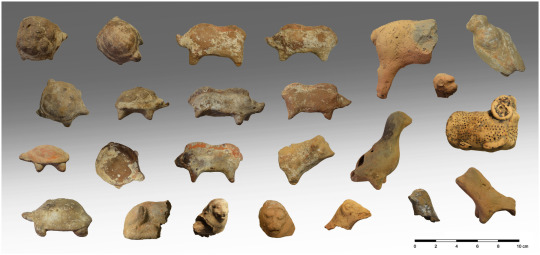


Greek Temple Complex Reveals Thousands of Votive Figurines
Archaeologists excavating a hilltop sanctuary on the Aegean Sea island of Kythnos have discovered “countless” pottery offerings left by ancient worshippers over the centuries, Greece’s Culture Ministry said Wednesday.
A ministry statement said the finds from work this year included more than 2,000 intact or almost complete clay figurines, mostly of women and children but also some of male actors, as well as of tortoises, lions, pigs and birds.
Several ceremonial pottery vessels that were unearthed are linked with the worship of Demeter, the ancient Greek goddess of agriculture, and her daughter Persephone, to whom the excavated sanctuary complex was dedicated.
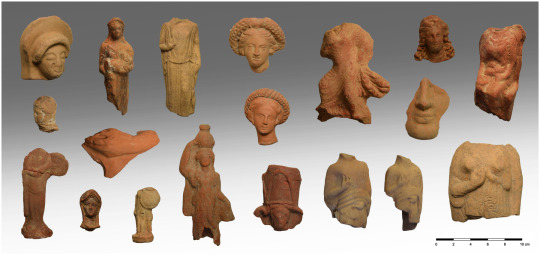
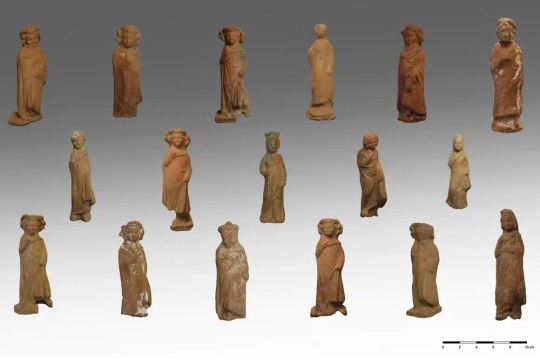
The seaside site of Vryokastro on Kythnos was the ancient capital of the island, inhabited without break between the 12th century B.C. and the 7th A.D., when it was abandoned for a stronger position during a period of pirate raids.
The artifacts came from the scant ruins of the two small temples, a long building close by that may have served as a temple storeroom and a nearby pit where older offerings were buried to make space for new ones. The sanctuary was in use for about a thousand years, starting from the 7th century B.C.



The excavation by Greece’s University of Thessaly and the Culture Ministry also found luxury pottery imported from other parts of Greece, ornate lamps and fragments of ritual vases used in the worship of Demeter and Persephone at Eleusis, an ancient Athens suburb.
It is unclear to what extent the site on Kythnos was associated with Eleusis — one of the most important religious centers in ancient Greece, where the goddesses were worshipped during secret rites that were only open to initiates forbidden to speak of what they saw. The sanctuary at Eleusis is known to have owned land on the island.
Kythnos, in the Cyclades island group, was first inhabited about 10,000 years ago. Its copper deposits were mined from the 3rd millennium B.C., and in Roman times it was a place of political exile.
The excavations are set to continue through 2025.
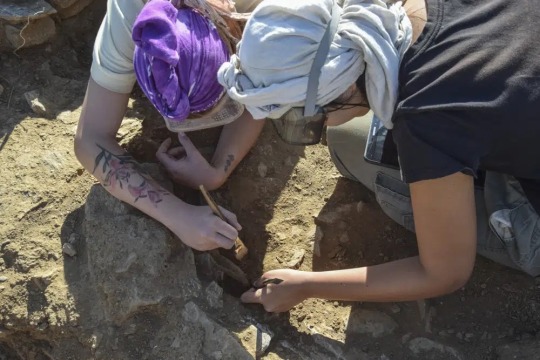
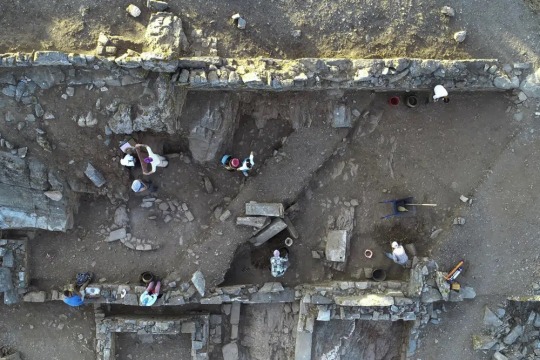
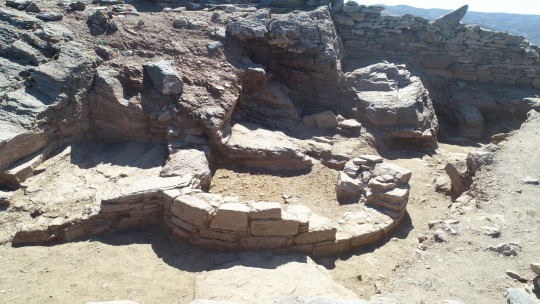

#Greek Temple Complex Reveals Thousands of Votive Figurines#island of kythnos#pottery#pottery offerings#ancient artifacts#archeology#archeolgst#history#history news#ancient history#ancient culture#ancient civilizations#ancient greece#greek history#greek art#long reads
530 notes
·
View notes
Text

Drum, 7th century B.C.E. Bronze, 9 x 5 7/8 in. (22.9 x 14.9 cm). Brooklyn Museum
This waisted drum is one of the earliest examples of a musical instrument from the Eurasian steppes in northeastern China. The decorated end was originally covered with a membrane of thin animal skin that served as a resonator. The three bands of running triangles and raised lines reflect the original stitching that would have affixed the membrane to the drum. Waisted drums of similar form, but sometimes of different materials, have been excavated from tombs at Pazyrk, in Siberia, and in northern China. Waisted drums fell out of favor in China in the Zhou dynasty (circa 1050–256 B.C.E.) but were reintroduced after the first millennium C.E., by foreign orchestras associated with Buddhism on the ancient Silk Roads.
22 notes
·
View notes
Note
‘Documenting my Jewish conversion’ your opinion on the last year means nothing, then. Absolutely nothing. You will never know the fear that real Jews have been facing since October 7th 2023, and you will never understand the risks that come from looking and acting like a Jew. You people shouldn’t even be allowed to call yourselves Zionists, because you have no ties to the holy land at all.
I bet you think Kahanism is ‘too much’, too.
Wow, Anon, this would really hurt my feelings if I believed for one second you were actually Jewish.
I could leave it at this and move on, but you know what? I'm feeling chatty and it's been a long time since I've made a big post on here, so let's sort out, piece by piece, why I know you're cosplaying.
For starters: if you were really Jewish, you wouldn't be anonymous. Jews who believe gerim aren't "real Jews" post their opinions on their blogs under their names. They are very few and far between, but they aren't shy. I believe that you have chosen to send this anonymously because you ARE shy... because your login info will demonstrate that you are an antisemitic goy who's trying to pick at what you assume is a sore spot.
Second, if you were really Jewish and you'd paid attention to what I've said about "the last year" (and then using the Gregorian calendar date, which is just funny to me), you would know that I haven't actually expressed an opinion on Zionism. I have reblogged material from other Jews expressing their opinions. Those Jews have ranged from Zionists to non-Zionists to post-Zionists to "refuse all terminology"-ists. I have chosen, deliberately, to do what we used to call signal boosting.
When I have expressed an opinion, it has been on the behavior of antisemites on Tumblr who pretend to be something they're not--usually, pro-Palestinian, but in your case, Jewish. I have been wondering what the "pro-Pal" fandom would do now that it's started to collapse from the fans getting bored, and you've demonstrated one possible tactic--so thanks for that!
Third, if you were really Jewish, you would have something to say about being Jewish that isn't what you said. I've read and spoken with countless Jews who talk about being Jewish. Look at the words you've chosen: "risk" and "fear". I have heard Jews express fear, and awareness of risk, but no Jew I've met would reduce all of Jewish experience to risk and fear.
The Jews I marked Yom Kippur with were aware of risk and had prudent fear. But they were not fearful. They were not obsessed with risk. They do not define their Judaism by terror, not even the little old lady in a foreign country who had bad ankles. I'm not going to tell you what the rest of Judaism entails, because you should know it yourself. I'm not going to make your anonymous cosplay easier for you by giving you explicit pointers.
Fourth, let's talk about "looking and acting like a Jew".
The man guiding my conversion has been physically attacked multiple times in the past three months, to the point where he has stopped wearing his kippah in public--especially around his own home because he's concerned someone will find said home and stalk/attack him and his wife. He is the leader of a group of Jews who are reinstating Judaism in a land where there have been no Jews in centuries. There will, for the first time in half a millennium, be a Torah in this part of the world due to his tireless efforts. He has, immeasurably, made the world a better, more spiritual, and more Jewish place. He is the guy the press and the government and the local Christian and Muslim groups contact if they want to ask about Jewish holidays or the opinion of the local Jewish population. He is the guy who writes all the statements put out by the local Jewish organization, of which he is the president and founder. In that sense, even taking off the kippah won't shield him--he is definitionally, visibly Jewish.
And you may tell yourself "Oh, he must be born Jewish if he's doing all that, so of COURSE he's got a lifelong experience with Judaism and of COURSE he's had a lifelong experience of antisemitism so of COURSE he knows more about all of this than you do, Fire."
This man is a convert.
He has, to use your attitude, "only" been Jewish for one-third of his life.
So, like, what did you mean by "looking and acting like a Jew" being a thing gerim know nothing about? What did you mean about how gerim cannot "look" or "act" like Jews enough to experience antisemitism? What was that about gerim not being entitled to opinions because of their ignorance on what being a Jew is like? What kind of phrenology are you practicing to determine who was a born Jew and who converted? What alchemy do you believe in in which the flesh of a born Jew has mystical qualia that mine does not?
I believe that I will enter the mikveh a ger, and I will emerge a Jew. My belief is in line with literally every rabbinical source I have encountered and the opinion of every single Jew I've ever read... except yours. Mysteriously, you don't believe the mikveh is a closed practice only for Jews, and that the only way a goy could ever be permitted to enter a mikveh is so that they will emerge from it Jewish, just as Jewish as those who emerged from their parents' wombs as Jews.
Why don't you believe that? Why are you the odd Jew out?
Is it because you're pretending to be Jewish to sow dissent and hurt random strangers for your own cruel pleasure? I sure think so!
Fifth, let's focus on the next bit in greater detail. Why do you think I'm a Zionist when I've never stated one way or the other?
I'll tell you why!
You found my name on one of the Zionist Blocklists that your fellow antisemites put together. I'm not on all of them, but I have ended up on at least one! And you're going through that blocklist, pretending to be Jewish in order to harass the Jews you found on there. You think you can try to trick me into abandoning my baby-eating ways by suggesting that the "real Jews" don't think I'm one of them.
The funny part about that is that I didn't end up on that list by being a Zionist on main. I ended up on that list by talking about my conversion process, reblogging pictures of Judaica, talking to Jews, and reblogging posts from Jews. That's it. That is why I know those blocklists are utter BS--because I, like dozens of other Jews would tell you if you weren't an antisemitic troll, wasn't on a Zionist Blocklist at all.
I was put on a list of Jews for the crime of being Jewish on Tumblr. You are trying to hurt me because I was visibly Jewish online. You are only here because you found me on a Jew-Hate List.
But go ahead and tell me I've no idea what antisemitism is, or what being visibly Jewish is like.
Sixth: very bold of you to assume I don't have any ties to Israel! Are you sure about that? Are you really sure? It's not something I have ever discussed on my blog, and it's interesting that you would assume this means the answer is "no", when it could just as easily be "I don't discuss that detail of my personal life online with total strangers who are also antisemites and disgraces to their hate movements".
Guess which one is the correct answer! Go on, guess!
Seventh, I don't actually care about what you think about my conversion, even if you are Jewish (you aren't--this is a hypothetical). Conversion isn't a popularity contest. There are a ton of people who don't accept my conversion because I'm going to be Masorti. There are a ton of other people who will assume I don't think they're Jewish because they're not Masorti.
And I just... don't really care about the argument, overall. There are several Jewish opinions which matter to me. The man who's guiding my conversion, the Rabbi teaching my conversion class, and the beit din who will interview me. That's actually pretty much it! If other Jews don't think I'm Jewish, they're entitled to their opinion and they don't have to spend time with me or invite me to their services. They're justified in controlling who accesses their sacred spaces. It'd be nice if they weren't jerks about it, but you can't always get what you want.
Just to be totally, abundantly clear, then: even if you were Jewish, you'd still be wrong to tell me that I'm not and that my opinion is meaningless. It's just useful to point out that you aren't Jewish, about which I have one more point to make!
And last (don't worry, I know you stopped reading long ago, but I like to be thorough), I do not know why you're asking me to refute, or support, an ideology for a nation in which I do not live. I don't have an opinion on Kahanism more complex than "I don't like what I've heard about it". If you'd asked me my opinion on the Vox/PP alliance in Spain, I could write for days! Or if you asked me about how horseshoe theory is validated by the alliance between red fash, green fash, and Republicans in the US--I can and have written about that, too!
I don't write about Israeli politics in depth for the same reason I don't write about the political situation in Ukraine, or Canada, or Myanmar, or Qatar, or Ghana, or Greenland, or any of the other places I don't live. It seems silly for me to pontificate on political situations I don't understand when, most often, all I can offer is what I already said: "sounds bad, if true".
Here, let me liberate you from your self-constructed prison: you don't have to have a strong and informed opinion on every single thing occurring on the face of the Earth. It's okay for you to not know stuff. You do not have to form a hard opinion instantaneously because a stranger on the Internet demanded it. You can, and should, plead ignorance and move on with your life. You will be a far happier person if you are not ruled by obsessive anxiety regarding things you don't know. STOP MAKING HOT TAKES.
But, of course, I kid. I know, the same as you, why you brought up Kahanism. It's because you're the same anon who's going around harassing Jews by pretending to be Jewish, and you finally learned how to spell "Kahanism" correctly, and you're very, very proud of yourself and wanted to show off.
I am glad you found out it's not spelled Khanism!
This is the thing, brother. You are lying through your teeth. You are trying so hard to hurt Jews, and you're convinced this tactic will work. You want to create infighting among all the zionazi scum you despise. You and folks like you pretended to be Jews who were outraged over a bar mitzvah being performed in a television program, and you pretend to be Jews who are salty about the existence of converts. But I've gotta tell you, as a ger, I can still see right through you. It's all pretense.
You are as Jewish as an Easter ham.
Give up the game, anon. You're not clever enough to play it.
#ask box#ask me anything#asked and answered#jumblr#jewish convert#jew by choice#jew in progress#jewish conversion#antisemitism#antisemitism on tumblr#anon hate#antisemitic anon#masorti
24 notes
·
View notes
Text
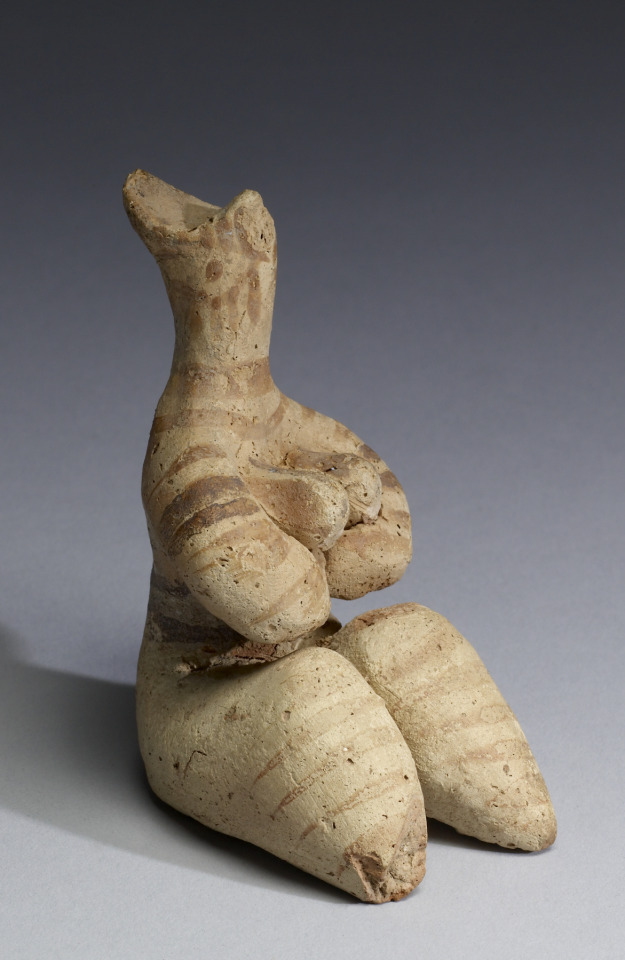
Tell Halaf Figurine
Syrian, 6th millennium BCE (Chalcolithic)
As early as the 7th millennium BCE, cultures in the Near East began to create organized settlements with well-developed religious and funerary practices. The Halaf culture of Anatolia (southern Turkey) and northern Mesopotamia is named for Tell Halaf in modern day Syria and is one example of such sophisticated early cultures. The Halaf culture flourished during the 6th millennium BCE and was notable for its ceramic productions, both its intricately painted pottery and remarkable female figurines.
81 notes
·
View notes
Text
How to reference in your grimoire
If you intend on sharing your grimoire with the public or you're a fan of a more academic style of writing then you're gonna want to reference your sources to avoid any kind of plagiarism.
You may have already learned how to reference at your college/uni, in which case follow that method, but if you haven't let me show you what i've been doing in my grimoire.
The referencing style I was taught in my degree is a form of APA 7th edition. This style is best for essays and small research papers and since my grimoire is essentially a bunch of mini contextual essays stuck together I thought it was appropriate.
Here's the format:
Author Surname, Author Initials. (Date of publication/release). Title of source: sub-heading/title of chapter. Publishing company/website. Place of publication/website link. [Format]
So for example, the book I'm currently reading is Buried by Professor Alice Roberts. If I were to reference this book in this format it would look something like this:
Roberts, A. (2023). Buried, An Alternative History of The First Millennium in Britain: Water and Wine. Simon and Schuster. London. [Book]
(Its up to you whether you decide to put the chapter before the book title, it doesn't make a difference, but I prefer doing it this way.)
This reference will need to follow an in-text citation. You can do that by adding a little number in parentheses next to your quote or paraphrase that corresponds to the number on your list of references OR you can make a mini reference following this method:
(Author Surname, Author Initials. (Date of publication). Page number if required)
So following this method an in-text citation would look like this:
(Roberts, A. (2023). p1)
Tips
If you are citing a source with multiple authors, organised them alphabetically by surname, your in text citation only needs to include the first one.
If you're referencing an online upload of an old source like Internet Archive or Project Gutenberg, include the original authors name first, uploaders name/ID second and mark which is which in parenthesis, then the date of original publication if you can find it, followed by the date it was uploaded to the site.
If you are referencing a film/TV episode, use the name of the director and include (Dir) next to their name.
If you can't find a date of publication/upload then write DNA instead.
Always put your references at the back of your grimoire. If your grimoire contains multiple chapters, group them by each chapter and then organise either alphabetically or chronologically. If your in-text citation uses numbers, organise your reference list chronologically. If you're using a mini reference, organise your reference list alphabetically.
This last bit is especially important for practitioners who intend to publish their work. Please please please do not skip referencing! I've read so many traditionally published witchcraft books who's authors don't do this or do it half-assed and I can't stand it.
Readers deserve to know where your information is coming from so they can be the judge on whether or not it's appropriate for them to practice themselves. Not doing so creates a cycle of ignorance among readers and new practitioners that encourages the spread of cultural appropriation, poor media literacy and poor historical and scientific understanding. Always cite your sources.
#witchblr#witch#witchcraft#pagan#pagan witch#paganism#grimoire#grimoire ideas#digital grimoire#grimoire tips#grimoire references#writing#journaling#witchcraft books#grimoire help#paganblr#practioner#book of magic
172 notes
·
View notes
Text
The Mast
One of the most important elements of a ship are the masts, because this is where the sails are attached that serve to propel the ship.
History
The oldest evidence for the use of one solid masts comes from the Ubaid site H3 in Kuwait, which dates back to the second half of the sixth millennium BC. There, a clay disc was recovered from a sherd that appears to depict a reed boat with two masts.

A painted clay disc with a diameter of 6.5 cm from site H3 with a design reminiscent of a boat with two masts, second half of the sixth millennium BC
In the West, the concept of a vessel with more than one mast to increase speed under sail and improve sailing characteristics developed in the northern waters of the Mediterranean: the earliest foremast was identified on an Etruscan pyxis from Caere (Italy) from the middle of the 7th century BC: A warship with a furled mainsail attacks an enemy ship and sets a foresail. An Etruscan tomb painting from the period between 475 and 450 BC depicts a two-masted merchant ship with a large foresail on a slightly inclined foremast.

Tomb of the Ship, mid-5th century BC
An artemon (Greek for foresail), which is almost as large as the main sail of the galley, is found on a Corinthian krater as early as the late 6th century BC; otherwise, Greek longships are uniformly depicted without this sail until the 4th century BC. In the East, ancient Indian kingdoms such as the Kalinga are thought to have been built in the 2nd century BC. One of the earliest documented evidence of Indian sail construction is the mural of a three-masted ship in the caves of Ajanta, which is dated to 400-500 AD.

This Ajanta mural depicts an ancient Indian ship with high stem and stern and three oblong sails attached to three masts. Steering-oars can also be seen. Location: Cave No. 2, Ajanta Caves, Aurangabad District, Maharashtra state, India, 400-500 AD
The foremast was used quite frequently on Roman galleys, where, tilted at a 45° angle, it was more like a bowsprit, and the scaled-down foresail attached to it was apparently used as a steering aid rather than for propulsion. While most ancient evidence is iconographic in nature, the existence of foremasts can also be inferred archaeologically from slots in the foremast feet, which were too close to the bow for a mainsail.

Fragment of mosaic depicting "navis tesseraria", a messenger and police boat of the African fleet, 2nd century AD
The artemon, together with the mainsail and the topsail, developed into the standard rigging of seagoing vessels in the Imperial period, which was supplemented by a mizzen on the largest cargo ships. The first recorded three-masters were the huge Syracusia, a prestigious object commissioned by King Hiero II of Syracuse and developed by the polymath Archimedes around 240 BC, as well as other Syracusan merchant ships of the time. The imperial grain freighters that travelled on the routes between Alexandria and Rome also included three-masted ships. A mosaic in Ostia (around 200 AD) shows a freighter with a three-masted rig entering the harbour of Rome. Specialised ships could carry many more masts: Theophrastus (Hist. Plant. 5.8.2) reports that the Romans brought in Corsican timber on a huge raft propelled by up to fifty masts and sails.
Throughout antiquity, both the foresail and the mizzen were secondary in terms of sail size, although they were large enough to require full rigging. In late antiquity, the foremast lost most of its tilt and stood almost upright on some ships.
By the beginning of the early Middle Ages, rigging in Mediterranean shipping had changed fundamentally: The spars, which had long since developed on smaller Greco-Roman ships, replaced the square sail, the most important type of sail in antiquity, which had virtually disappeared from the records by the fourteenth century (while remaining predominant in northern Europe). The dromon, the rowed bireme of the Byzantine fleet, almost certainly had two masts, a larger foremast and one amidships. Their length is estimated at 12 metres and 8 metres respectively, somewhat less than that of the Sicilian war galleys of the time.
Multi-masted sailing ships were reintroduced to the Mediterranean in the late Middle Ages. Large ships became more common and the need for additional masts to steer these ships appropriately grew with the increase in tonnage. Unlike in antiquity, the mizzen mast was introduced on medieval two-masted ships earlier than the foremast, a process that can be traced back to the mid-14th century based on visual material from Venice and Barcelona. To equalise the sail plan, the next obvious step was the addition of a mast in front of the main mast, which first appears in a Catalan ink drawing from 1409. With the establishment of the three-masted ship, propelled by square sails and battens and steered by the pivot-and-piston rudder, all the advanced ship technology required for the great transoceanic voyages was in place by the early 15th century.
In the 16th century, the cross-section of the masts was made up of several pieces of wood and held together with ropes and iron rings.

A lower mast with sections from 1773 to 1800
In order to achieve a greater height, the lower mast is extended, so that a total length of up to 60 metres can be achieved, measured from the keel. From lowest to highest, these were called: lower, top, topgallant, and royal masts. Giving the lower sections sufficient thickness necessitated building them up from separate pieces of wood. Such a section was known as a made mast, as opposed to sections formed from single pieces of timber, which were known as pole masts.

This is a section of HMS Victory's main mast
The forces of the sails on the mast construction are transferred to the hull construction by standing and running rigging, forwards and aft (stern) by stays, and laterally by shrouds or guys. In order to enable sailors to climb up into the rigging, which is particularly necessary for the operation of square riggers, rat lines are knotted into the shrouds like rungs of a ladder. The upper end of a ship's mast is called the masthead.
Mounting
The mast either stands in the mast track on the keel and is passed through the deck or it stands directly on deck. In the first case, the opening must be neatly sealed with a mast collar, otherwise water will penetrate into the living quarters. If the mast is on deck, it must be supported from below on the keel so that the loads do not bend the deck. Practically every sailing ship therefore has a more or less visible vertical support through the cabin.
Masts are usually supported by the standing rigging. The shrouds pull the mast downwards with several times its own weight and thus prevent it from tipping over.
Traditionally, when a sailing ship is built, one or more coins are placed under the mast as a lucky charm (according to my theory, the coins were also used as money to pay Charon the ferryman in the underworld if the ship sank); this custom is still practised today. Just as a horseshoe was nailed to the mast to bring good luck.
Mast types
For square-sail carrying ships, masts in their standard names in bow to stern (front to back) order, are:
Sprit topmast: a small mast set on the end of the bowsprit (discontinued after the early 18th century); not usually counted as a mast, however, when identifying a ship as "two-masted" or "three-masted"
Fore-mast: the mast nearest the bow, or the mast forward of the main-mast. As it is the furthest afore, it may be rigged to the bowsprit. Sections: fore-mast lower, fore topmast, fore topgallant mast
Main-mast: the tallest mast, usually located near the center of the ship Sections: main-mast lower, main topmast, main topgallant mast, royal mast (if fitted)
Mizzen-mast: the aft-most mast. Typically shorter than the fore-mast. Sections: mizzen-mast lower, mizzen topmast, mizzen topgallant mast
Some names given to masts in ships carrying other types of rig (where the naming is less standardised) are:
Bonaventure mizzen: the fourth mast on larger 16th-century galleons, typically lateen-rigged and shorter than the main mizzen.
Jigger-mast: typically, where it is the shortest, the aftmost mast on vessels with more than three masts. Sections: jigger-mast lower, jigger topmast, jigger topgallant mast
When a vessel has two masts, as a general rule, the main mast is the one setting the largest sail. Therefore, in a brig, the forward mast is the foremast and the after mast is the mainmast. In a schooner with two masts, even if the masts are of the same height, the after one usually carries a larger sail (because a longer boom can be used), so the after mast is the mainmast. This contrasts with a ketch or a yawl, where the after mast, and its principal sail, is clearly the smaller of the two, so the terminology is (from forward) mainmast and mizzen. (In a yawl, the term "jigger" is occasionally used for the aftermast.)
Some two-masted luggers have a fore-mast and a mizzen-mast – there is no main-mast. This is because these traditional types used to have three masts, but it was found convenient to dispense with the main-mast and carry larger sails on the remaining masts. This gave more working room, particularly on fishing vessels.
Cock, John. A treatise on mast-making , 1840.
Fincham, John. A Treatise on Masting Ships and Mast Making , 1854. Kipping, Robert. Rudimentary treatise on masting, mast-making, and rigging of ships , 1864.
Steel, David The Elements and Practice of Rigging, Seamanship, and Naval Tactics, Including Sail Making, Mast Making, and Gunnery , 1821.
Steel, David. Steel's Elements Of Mast-making, Sail-making and Rigging , 1794.
Layton, Cyril Walter Thomas, Peter Clissold, and A. G. W. Miller. Dictionary of nautical words and terms. Brown, Son & Ferguson, 1973.
Harland, John. Seamanship in the Age of Sail,1992
Marquardt, Karl Heinz, Bemastung und Takelung von Schiffen des 18. Jahrhunderts, 1986
#naval history#mast#parts of a ship#very long post#sorry#ancient seafaring#medieval seafarinh#age of discovery#age of sail#age of steam
104 notes
·
View notes
Text
The "ERA"s of Doctor Who:
I honestly think the "Truman Show" theme this season is BBC/Disney's way of establishing an "alternate reality" for the audience-- sorta like breaking-the-fourth-wall type of "NEW ERA" for Doctor Who. They're literally signaling both OLD fans and NEW viewers: "HI! WE LEFT THE OLD ERA OF DOCTOR WHO, THIS IS A NEW ERA!" I don't think they'll ever explore Fourteen's life with Donna on TV again. I think that part of the Doctor's life is now left to the comic book realities and fandom's imagination.
Thing is, DW has been running for so long that it literally evolved from the outside inwardly, into multiple different timelines and realities. Much like our lives, right?--some only have chapters, others have volumes, others have sequels, prequels, etc.
I personally can categorize the different eras of Doctor Who into the following:
"Classic Who" 1960s - #1-3rd Docs = the real "Classic Who"
"Baker Who" 1970s - #4th Doctor = not sure how to categorize Tom Baker's years; it was certainly a mix of "Classic" AND tech-evolution of the 80s ; I personally call it the "booming era" of DW!
"Psychedelic Who" 1980s - #5-7th Docs = these were the years of "Exploring Gallifrey Mythos"; as well as, exploring the inner philosophies and politics of the Doctor's peoples. This was the "era" when the show's new producers decided to integrate the Doctor's "roots" as a Time Lord into the show's overall continuous adventures.
"Re-Birth Who" 90s/millennium - #8-9th Docs = the era when Time War "goes global"! Production-wise, DW needed a big reason to explain the Doctor's disappearance.
"New Who" early 21st century - #10-12th Docs = "False Memory" years, aka "The Retcon Era" LMAO , aka "The Years of Unnecessary Drama" HEHEHEHEH, aka the "I have lost track of where Gallifrey is era"! HAHAHHAHAH! ...ALL JOKES ASIDE, the Doctor's "re-birth" as a character was exemplified through the process of "re-integrating" all his past lives in the eyes of his NEW companions (Rose, Martha, Donna, Amy, Clara, and Bill). In this series, we see his companions play CENTRAL roles in the advancement of the "Who Narrative". The New Who adventures were basically about the Doctor re-discovering himself through his companions' PERSONAL STORIES.
"Re-Incarnation Who" 2010s - #13-14 Docs = This was the short-run era we just had during the pandemic. The producers wanted very much to revive the show's spark; thus, they took all the Classic Who aspects of the original series and EXPANDED its reality into an ALTERNATE/"FORGOTTEN" TIMELINE. For example, we are given brand new "old characters" like the Fugitive Doctor and her new "old" companions. This "era" gave birth to the ALTERNATE timeline we are now being introduced to....
"Modern Who" 2020s - #15th Doctor and beyond = a mystery.
#doctor who#classic who#russell t davies#fifteenth doctor#fourteenth doctor#tom baker#fourth doctor#new who#fugitive doctor#Jo Martin#Jodi Whittaker
46 notes
·
View notes
Text
Pillar figurine—Lachish, Judah (now Israel/Palestine), 8th to 7th century BCE

According to the Met: "This type of pillar figurine is typical of those produced in great numbers in the kingdom of Judah at this time. Tell el-Duweir is ancient Lachish, the major fortified center in Judah that was destroyed by the Assyrian army under Sennacherib (701 B.C.). The city's fate is chronicled in the Bible and represented in wall reliefs from the Assyrian palace at Nineveh. This buxom goddess figurine with pillar base is nude and supports her breasts in her hands. The head is simply rendered with a short, tightly curled caplike hairdo articulated in ridges, and the facial features are mold-made and clearly articulated. This imagery and that on clay plaques with nude female figures probably represents fertility or mother goddesses. The figurines are found in domestic contexts and point to popular cults that coexisted with monotheistic Judaism. Outside influences are evident in the religion of ancient Israel and Judah at this time, and Syrian cults focusing on the worship of Asherah may have been an influence. Asherah was the wife of El, head of the Canaanite pantheon, and probably the mother of the gods in Canaanite and later Jewish tradition. Some literary evidence in ancient Israel even speaks of Asherah as the consort of Hashem [the Met includes the tetragrammaton here] himself."
Here are some other female figurines in the Met's collection that use similar poses and come from surrounding areas.

This statue from northwestern Iran in the early first millennium BCE.

^ This Mesopotamian or Syrian figure from much earlier, around 5600-5000 BCE.

^ This Neo-Elamite part of a vessel from Southwestern Iran around the same time as the Judean Pillar Statues (8th-7th century BCE).

Another vessel in the shape of a woman from Northwestern Iran, also around the time of the Judean Pillar Statues (9th-7th century BCE).
#judean pillar statues#jewish history#ancient art#ancient history#jewish#jewish art#israel#israel/palestine#iran#ancient iran#mesopotamia#judah#ancient syria
16 notes
·
View notes
Text
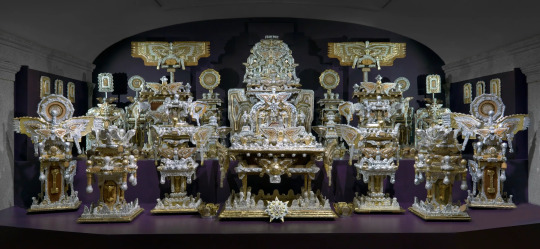
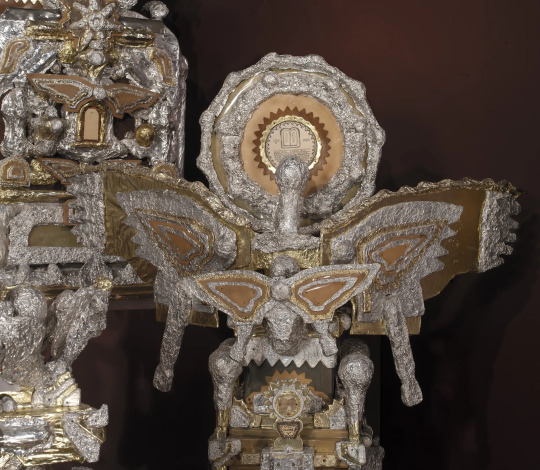
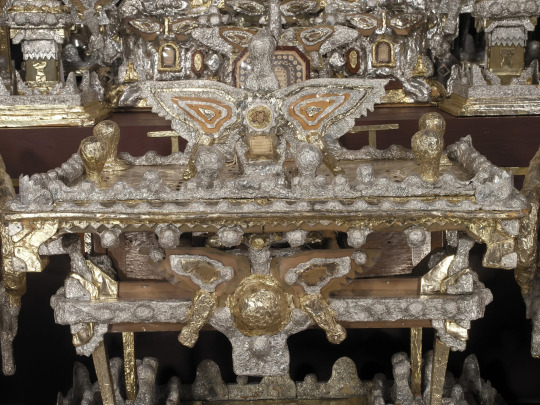
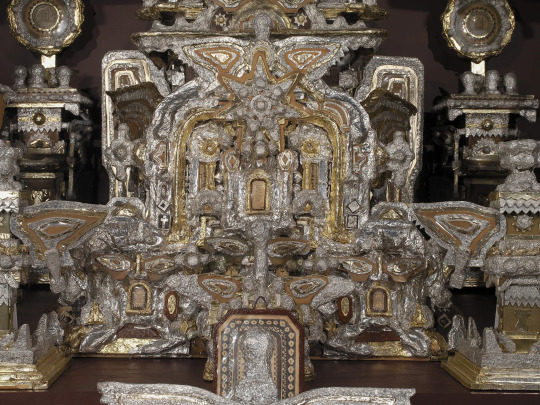
No, you know what? While I'm all fired up about modern art and outsider art, let me introduce you to the works of James Hampton.
Pictured above is his monumental Throne of the Third Heaven of the Nations' Millennium General Assembly.
With scant education and no formal art education, James Hampton made these pieces out of his intense religious fervor and his own desire to create:
In 1950, Hampton rented a garage on 7th street in northwest Washington [DC]. Over the next 14 years, Hampton built a complex work of religious art inside the garage with various scavenged materials such as aluminum and gold foil, old furniture, pieces of cardboard, light bulbs, jelly jars, shards of mirror and desk blotters held together with tacks, glue, pins and tape. The complete work consists of 180 objects, many of them inscribed with quotes from the Book of Revelation. The centerpiece of the exhibit is a throne, seven feet tall, built on the foundation of an old maroon-cushioned armchair with the words "Fear Not" at its crest. The throne is flanked by dozens of altars, crowns, lecterns, tablets and winged pulpits. Wall plaques on the left bear the name of apostles and those on the right list various biblical patriarchs and prophets such as Abraham and Ezekiel. The text The Throne of the Third Heaven of the Nations' Millennium General Assembly was written on the objects in Hampton's handwriting.
He constructed all his pieces from materials he found or scavenged himself, "such as aluminum and gold foil, old furniture, pieces of cardboard, light bulbs, jelly jars, shards of mirror and desk blotters held together with tacks, glue, pins and tape."
It's not clear if Hampton himself regarded himself as an artist, a visionary, a prophet, or none of the above. His work, however, is regarded as art in the same way that Michelangelo's Pieta is regarded as art: art of a religious subject or concept.
He also "kept a 108-page loose-leaf notebook titled St James: The Book of the 7 Dispensation. Most of the text was written in an unknown script that remains undeciphered. ... Some of the text was accompanied by notes in English in Hampton's handwriting. In the notebook, Hampton referred to himself as St. James with the title 'Director, Special Projects for the State of Eternity' and ended each page with the word 'Revelation'."
The art was not discovered until after Hampton's death in 1964, when the owner of the garage, Meyer Wertlieb, came to find out why the rent had not been paid. He knew that Hampton had been building something in the garage. When he opened the door, he found a room filled with the artwork. Hampton had kept his project secret from most of his friends and family. His relatives first heard about it when his sister came to claim his body. When Hampton's sister refused to take the artwork, the landlord placed an advertisement in local newspapers. Ed Kelly, a sculptor, answered the advertisement and was so astounded by the exhibit, he contacted art collector Alice Denney. Denney brought art dealers Leo Castelli and Ivan Karp, and artist Robert Rauschenberg, to see the exhibit in the garage. Harry Lowe, the assistant director of the Smithsonian Art Museum, told the Washington Post that walking into the garage "was like opening Tut's tomb."
His work is now on display at the Smithsonian American Art Museum.
106 notes
·
View notes